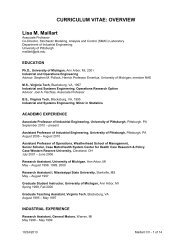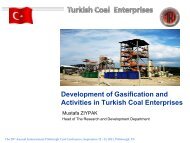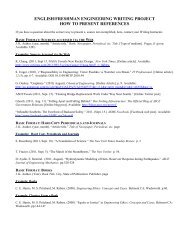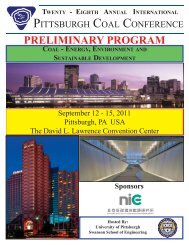Abstract Booklet 2006 - Swanson School of Engineering - University ...
Abstract Booklet 2006 - Swanson School of Engineering - University ...
Abstract Booklet 2006 - Swanson School of Engineering - University ...
You also want an ePaper? Increase the reach of your titles
YUMPU automatically turns print PDFs into web optimized ePapers that Google loves.
In the present work, NETL researchers have studied chemical looping combustion<br />
(CLC) with an oxygen carrier NiO/bentonite (60 wt.% NiO) for the IGCC systems<br />
utilizing simulated synthesis gas. Multi cycle CLC was conducted with NiO/Bentonite<br />
in TGA at atmospheric pressure and in a high pressure reactor in a temperature range<br />
between 700- 900°C. Global reaction rates <strong>of</strong> reduction and oxidation as a function <strong>of</strong><br />
conversion were calculated for all oxidation-reduction cycles utilizing the TGA data.<br />
The effect <strong>of</strong> particle size <strong>of</strong> the oxygen carrier on CLC was studied for the size<br />
between 20-200 mesh. The multi cycle CLC tests conducted in a high pressure packed<br />
bed flow reactor indicated constant total production <strong>of</strong> CO 2 from fuel gas at 800°C and<br />
900°C and full consumption <strong>of</strong> hydrogen during the reaction.<br />
43-2<br />
Substitute Natural Gas from Coal Co-Production Project - A Status Report<br />
John Ruby, Sheldon Kramer, Nexant, Inc., USA<br />
Raymond Hobbs, Arizona Public Services, USA<br />
Bruce Bryan, Gas Technology Institute, USA<br />
The US DOE National Energy Technology Laboratory awarded four co-production<br />
projects in December 2005. This paper presents the status and early results from the<br />
project sponsored by Arizona Public Service Company (APS). The 3-year project will<br />
research and develop a hydrogasification process to co-produce substitute natural gas<br />
(SNG) and electricity from western coals. The proposed system uses hydrogen instead<br />
<strong>of</strong> air or oxygen in the gasification process, an approach that <strong>of</strong>fers higher operating<br />
efficiencies, lower water consumption, and a gas product that is richer in methane than<br />
other gasification processes. The concept has the potential to produce SNG below the<br />
projected market price for natural gas. It will separate a carbon dioxide stream ready<br />
for sequestration. In the first year the project will focus on concept design and<br />
laboratory tests; the overall objective will be to field test the hydrogasification SNG<br />
concept at one <strong>of</strong> the APS power stations.<br />
43-3<br />
Co-Production <strong>of</strong> Substitute Natural Gas and Electricity via<br />
Catalytic Coal Gasification<br />
Brian S. Turk, Raghubir Gupta, RTI International, USA<br />
Although coal is well known to be the most abundant fossil fuel available on this<br />
planet, its reputation as a fuel is tarnished by its inconvenient solid form, complexity<br />
for converting into useful energy and work, pollution, and a negative public image that<br />
discourages coal use. In a recently funded DOE project, RTI plans to develop key<br />
technologies to convert coal into two more desirable energy forms, namely substitute<br />
natural gas and electricity. RTI’s technology platform is based on extensive research<br />
performed by Exxon in the 1970’s for substitute natural gas (SNG) production via<br />
catalytic gasification. Unfortunately, this process was not economically viable because<br />
an extensive recovery process was necessary to recover the active catalyst from the ash<br />
to mix with the coal feed, the active catalyst and ash reacted at the operating conditions<br />
inhibiting effective catalyst recovery, and cryogenic separation was used to separate an<br />
SNG product and a hydrogen and carbon monoxide recycle stream. RTI has adapted a<br />
number <strong>of</strong> newer and novel technologies to overcome these problems and<br />
simultaneously achieve near zero emissions, produce a high pressure CO 2 product and<br />
co-produce electricity. In the proposed process, the active catalyst material is loaded on<br />
a support material and remains fixed in a catalytic reactor. The coal is initially<br />
preprocessed to convert the coal into a mixture <strong>of</strong> gas phase carbon species, H 2 and<br />
solid char fines prior to the catalytic reactor. In the catalytic reactor, the catalyst<br />
promotes the conversion <strong>of</strong> the gas phase carbon species and H 2 into CH 4 . Because the<br />
ash is trapped in the solid char fines and the catalyst on a support, physical contact<br />
between the ash and catalyst is impossible eliminating the potential for reaction. The<br />
product gas mixture from the catalytic reactor is cleaned using the hot gas<br />
desulfurization and CO 2 capture technologies that have been developed at RTI. The<br />
product from the CO 2 capture process is a high pressure sequestration ready CO 2<br />
byproduct. More conventional ammonia and methanation processes will be used to<br />
polish the final SNG to meet pipeline specifications. Finally, the carbon trapped in the<br />
char fines is combusted in a pressurized fluid-bed combustor to generate steam and<br />
electricity. This presentation will describe the available results from the bench-scale<br />
testing program for evaluating the technical and economic feasibility <strong>of</strong> the proposed<br />
process.<br />
43-4<br />
Fundamentals <strong>of</strong> an Optimized Catalyst Gasification System<br />
Edwin Hippo, Raman Mahato, James May, Narcrisha Norman, Even Odell, Southern<br />
Illinois <strong>University</strong>, USA<br />
Aarron Mandell, GreatPoint Energy, USA<br />
GreatPoint Energy has begun the development <strong>of</strong> a catalytic gasification process. This<br />
process is aimed at operating at lower gasification temperatures than processes<br />
previously developed. In conjunction with GreatPoint Energy, The Department <strong>of</strong><br />
Mechanical <strong>Engineering</strong> and Energy Processes at Southern Illinois <strong>University</strong> at<br />
Carbondale has initiate fundamental studies to determine the feasibility <strong>of</strong> converting<br />
coal into methane while keeping processing temperatures below 700°C. These studies<br />
have included basic thermodynamics, laboratory scale gasification tests and laboratory<br />
38<br />
catalyst recovery tests. Three types <strong>of</strong> laboratory gasifiers have been developed. These<br />
gasifiers were used to screen catalysts systems, and process variables. Catalyst<br />
recovery screening was conducted in a Soxhlet extractor. The results demonstrate that<br />
coal can be converted to methane at temperatures as low as 500°C within reasonable<br />
reaction times <strong>of</strong> less than 1 hour and as short as 15 minutes. The optimum catalyst<br />
system utilized thus far, consists <strong>of</strong> two catalyst. One catalyst apparently activates a<br />
second catalyst to accomplish very rapid low temperature conversion <strong>of</strong> the coal. There<br />
are many advantageous to the low temperature operation, They include lower steam<br />
requirements, decrease gas separation costs, less catalyst tie-up with mineral<br />
constituents, higher catalyst recovery, smaller boiler requirements, higher methane<br />
concentration in the product gases, and less gas recycle. Basic thermodynamics will be<br />
discussed. The paper will report results from batch, high pressure mini-gasifiers, semi<br />
continuous, high pressure, mini fluid bed gasifier, and a differential bed gasifier.<br />
Future development plans will be discussed.<br />
43-5<br />
A Novel Catalytic Coal Gasification Process to Produce SNG<br />
Francis Lau, GreatPoint Energy, USA<br />
GreatPoint Energy is commercializing a novel catalytic process for converting coal<br />
(and other carbon-based feedstocks) into high value clean substitute natural gas (SNG).<br />
Coal is available in abundance in the United States and will ensure a secure and an<br />
affordable fuel for many generations. GreatPoint converts this low cost, but dirty<br />
feedstock into the cleanest <strong>of</strong> all commercially viable fuels. GreatPoint s substitute<br />
natural gas product, called bluegas TM , meets pipeline quality gas requirements, and is<br />
transported by standard natural gas pipeline. Production can be centralized in close<br />
proximity to the coal mine, where over half <strong>of</strong> the carbon (in the form <strong>of</strong> CO 2 ) can be<br />
sequestered. GreatPoint Energy intends to build, own, and operate bluegasTM<br />
production facilities and sell bluegasTM to regional distributors and customers in the<br />
power generation, industrial, heating and chemical sectors. The company s technology<br />
is based on the discovery that coal mixed with mixtures <strong>of</strong> alkali metal catalysts<br />
promotes coal gasification reactions including methanation at mild conditions, around<br />
500 to 700°C. Research into this finding has a led to a one-reactor system which <strong>of</strong>fers<br />
an efficient and cost-effective route to produce low cost methane from coal. The<br />
objective <strong>of</strong> this paper is to describe the bluegasTM process, the status <strong>of</strong> the<br />
technology, and areas <strong>of</strong> new process development.<br />
44-1<br />
SESSION 44<br />
COAL CHEMISTRY, GEOSCIENCES, AND RESOURCES:<br />
MINERAL MATTER, COAL ASH, COAL COMBUSTION<br />
Characterization <strong>of</strong> Source Rocks Producing Respirable Quartz and<br />
Aluminosilicate Dust in Underground US Coal Mines<br />
Steven Schatzel, NIOSH, PRL, USA<br />
A research effort has been undertaken at the Pittsburgh Research Laboratory (PRL) <strong>of</strong><br />
the National Institute <strong>of</strong> Occupational Safety and Health (NIOSH) to characterize the<br />
source material producing respirable quartz and aluminosilicate dust in coal mines.<br />
Mine regulatory personnel suggested that problematic silicate mineral dust<br />
concentrations were known in some coal mines operating in southern West Virginia,<br />
Virginia and eastern Kentucky. Six mines were selected in this region for rock and dust<br />
sampling by PRL researchers based on elevated quartz concentrations in historical dust<br />
samples. Four <strong>of</strong> the coal mines sampled produced elevated respirable quartz dust<br />
concentrations on active production sections during sampling, the other two mines<br />
produced about 5% quartz, the regulatory reduced standard limit for quartz. Prior<br />
research has suggested that the source <strong>of</strong> respirable silicate dust in underground coal<br />
mines is typically immediate ro<strong>of</strong> or floor lithology, not mineral matter bound within<br />
the mined coalbed. At some <strong>of</strong> the sites included in this research there were only<br />
potential quartz source rocks in either the floor or the ro<strong>of</strong> units. At other sites sampled<br />
during the study, potential quartz sources existed in both the ro<strong>of</strong> and floor lithologies.<br />
In the later cases, elemental data have suggested the enrichment <strong>of</strong> certain cations in<br />
the ro<strong>of</strong> lithologies compared to floor rock may have the potential to distinguish<br />
potential quartz and aluminosilicate sources produced in respirable dust samples.<br />
Research results from Pennsylvanian-age coalbeds in western Pennsylvania surface<br />
mine sites has suggested the clastically derived mineral matter in the immediate ro<strong>of</strong><br />
rock, coal-bound mineral matter and the immediate floor lithology are derived from a<br />
common source material. Some <strong>of</strong> the enrichment <strong>of</strong> certain cation species in the ro<strong>of</strong><br />
units (i.e., Ca, Fe, Mg, Na) compared to immediate floor rock may be related to the<br />
percolation <strong>of</strong> fluids through the overburden and diminished probability for fluids to<br />
migrate effectively through the coal or coal precursor and into the floor units.<br />
Comparisons <strong>of</strong> the elemental composition <strong>of</strong> dust cassette mineral matter and possible<br />
source rocks have shown that the dust composition is not identical to any <strong>of</strong> the<br />
sampled potential sources rocks. It is considered likely that the mining process,<br />
including rock breakage and the entrainment <strong>of</strong> dust particles in the ventilation air<br />
stream have modified the dust composition from the starting parent materials.<br />
However, normalizing the data has shown promise in distinguishing potential source














